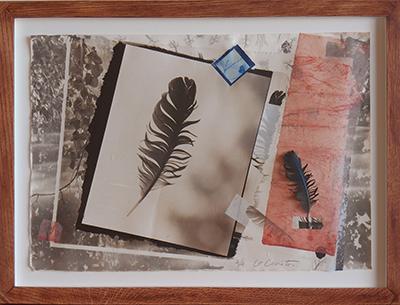Kurita and Shikama: Transformative Visions

Koichiro Kurita has a way with rocks, with trees, with ponds, indeed with nature in all its forms in straightforward photography, and, more recently, with collage. His insanely textural and captivating images are on view at Ille Arts in Amagansett with Takeshi Shikama’s photographs from his “Urban Forests” and “Garden of Memory” series.
Their work complements each other, but Mr. Kurita is definitely the scene-stealer. His images are large-format, irregularly sized to fit the specific subject matter, and, in the case of the collages, incorporate a range of subjects and objects with beautiful symmetry and asymmetry.
His metier is texture. A snowy field with a narrow and winding patch of grass that looks like dense fur is arresting and confusing at first, and then mesmerizing. His preferred process, a calotype paper negative used to make platinum, albumen, and salt prints, is a nod to the era of Henry David Thoreau, whose philosophy of nature Mr. Kurita admires. Thoreau’s “Walden” inspired him to leave his lucrative job in commercial photography and follow his muse at the age of 40. Since then, he has been dedicated to capturing images of nature and relating them in soft, tonal prints on handmade Japanese gampi tree paper.
He applies an emulsion by hand, takes an image and develops the negative for several minutes, and prints it the next day. The uneven borders of the image underline the handmade painstaking process. The way light moves in the landscape, particularly over grass and other plant life, is tactile. The overall effect is lyrical, mysterious, and surreal.
One of his favorite presentation strategies is to group prints on contact sheets so that the parts of one object or subject come together for a discernible whole, whether they be trees, a landscape, or even buildings. It is a bravura approach, but one of the only things that might be made easier by his process.
He also presents large-format single-image prints, and these too are quite beautiful. His views of the convergence of plants and bodies of water, such as ponds, create visual confusion, which gradually resolves itself and then inspires wonder. “See Through” is one example. The grasses and their reflection on the water seem to suspend the water lilies within their stalks. The first impression is that it may be a double exposure, but the eye finally apprehends it. Once understood, the image is made more spectacular.
His unique collage pieces in the “No Anonymous” series are like mini shadow boxes, with frames the artist makes himself, which he also does for his prints. In “Stone” as in “Feather,” he layers images and objects in a way that tells a story about their inception and realization. Set in the bottom of the frame of “Stone” is the stone, a small object that has been photographed and blown up to heroic proportions to take up most of the frame. A small negative is attached to the image.
The show also includes a few works that incorporate his contact-print format to photograph portions of various plant forms. The subject of the photograph is then attached to the same-sized blocks containing no image, and presented in mirror form in one case and in the same direction in the other. A long strip of prints of several objects includes the real objects in a similar fashion, an assortment of small buds and seeds from trees. They are delightful.
In all of this vibrant capturing of nature, Mr. Shikama’s small, identically sized static images of stuffed animals in staged settings from the American Museum of Natural History seem even more stilted and uncomfortable than they might otherwise. He, too, makes platinum prints on gampi paper, and his images have the same warmth and tonality of Mr. Kurita’s prints.
Mr. Shikama is also interested in the natural world, including a lovely and ennobling series of Central Park, but in this case he appears to take an ironic approach. It also offers a confounding approach to presentation. Once again, the eye is not certain it understands what it is seeing. Where does the two-dimensionality of the faux background of the museum’s diorama start and the three-dimensional still life end? In these 7 1/2-by-7 1/2 small-format images, it is eventually apparent, but the straightforward subjects also have a modicum of the unearthly or the surreal.
The show will be up through July 13.
